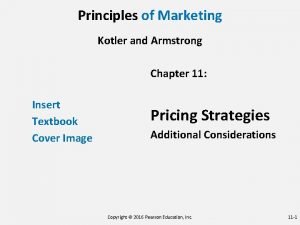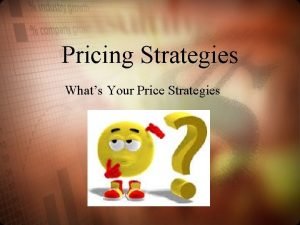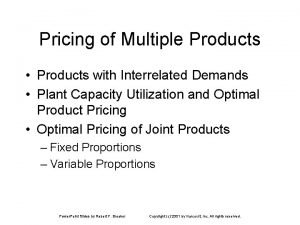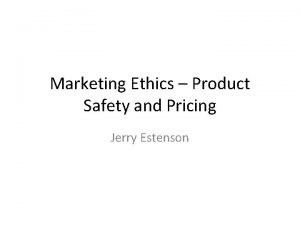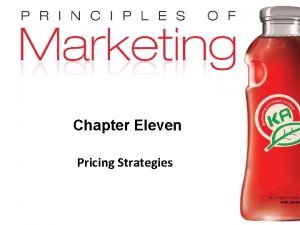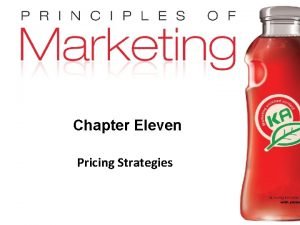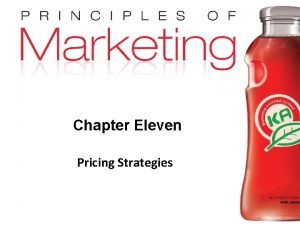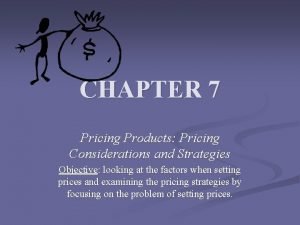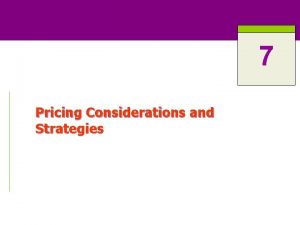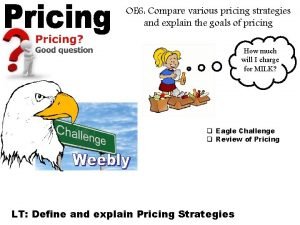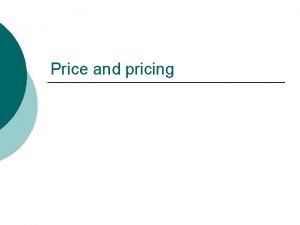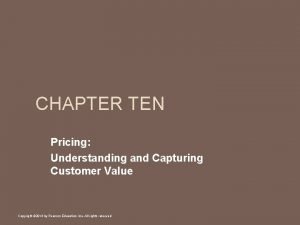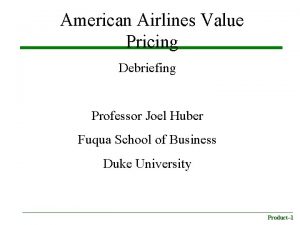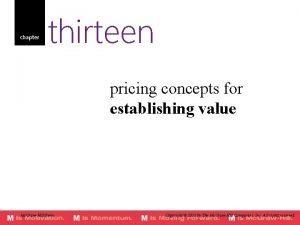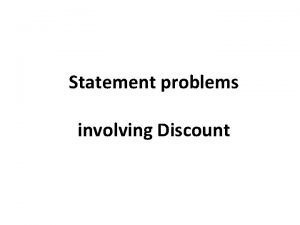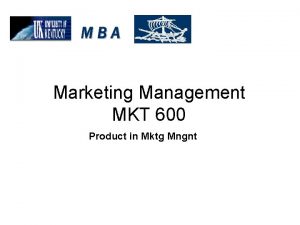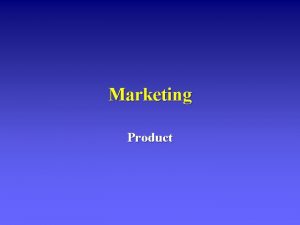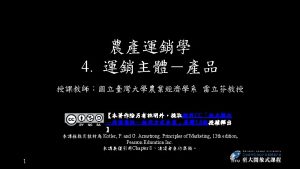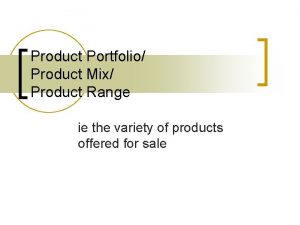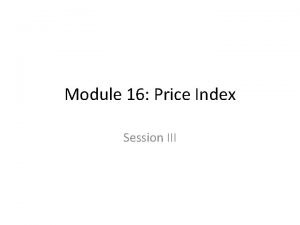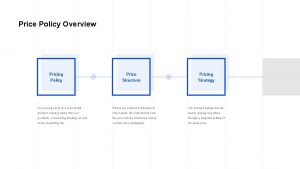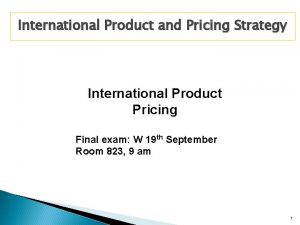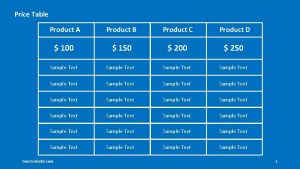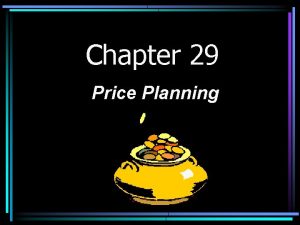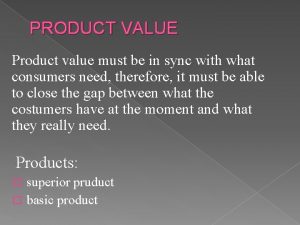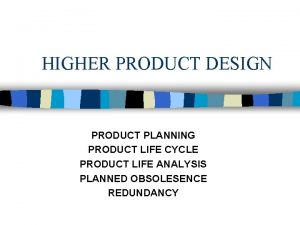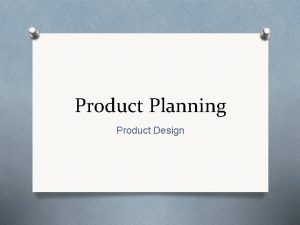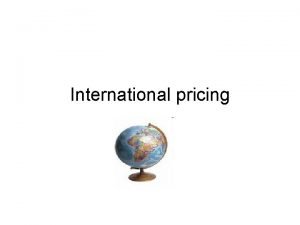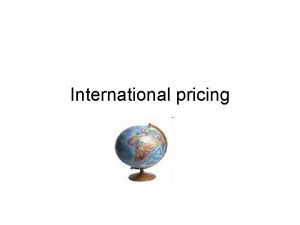Pricing Price Planning Pricing Product Value Price is








































- Slides: 40

Pricing Price Planning

Pricing = Product Value Price is the value of money placed on a good or service Value is a matter of anticipated customer satisfaction Seller must gauge where product ranks in anticipated satisfaction (value) Set price HIGH enough for a profit but LOW enough to still meet customer’s value

Forms of Price is involved in every exchange regardless of the term (word) you use: Some Examples of Terms used for price: Fee Admission Interest Toll Salary Rent Wage Bonus Commission Dues Tuition

Importance of Price is an important factor in the success or failure of a business Provides an Image Gain Competitive Edge Helps Determine Profits

Importance (IMAGE) Does the company want to position itself as a high priced, elite business or as a low priced, discount business? To most customers, high price means better quality, upscale. To most customers, low price means better value or more for their money

Importance (COMPETITIVE EDGE) Price may be the advertising strategy that differentiates companies. “We are the lowest price in town…” “We will beat any deal…” Price may be the critical role in establishing an edge over another company.

Importance (PROFITS) PROFIT = REVENUE – COST Price helps determine revenue (sales) !! Revenue = Price * Quantity Sold High price means more revenue per each unit, but may also mean fewer units sold.

Importance (PROFITS) An increase in price may not mean an increase in revenue. WHY? (If you increase your price, do you make more money? ) Price $ 30 $ 27 $ 24 $ 21 X Qty Sold 100 120 130 145 = Revenue $ 3, 000 $ 3, 240 $ 3, 120 $ 3, 045

Goals of Pricing Gaining Market Share Meeting the Competition Return on Investment (ROI)

Gaining Market Share – Percentage of total sales generated by all competitors in an industry (A Piece of the Pie)

Gaining Market Share (cont. ) Business may forgo short term profits to gain market share. (Lower their prices to get a bigger piece of pie) WHY is Market Share Important? 1) Reputation (clout with customers) – Brand Name 2) Bargaining power w/ suppliers and channel members (lower prices, faster service, etc)

Gaining Market Share (Cont) Market Position – Company’s standing in a market based on their market share 1) Ford F-150 2) Chevy Silverado 3) Dodge Ram Ford can make statements like: “Number one selling truck in America…”

Market Share Project

Goals of Pricing Gaining Market Share Meeting the Competition Return on Investment (ROI)

Meeting the Competition Some simply aim to meet the prices of their competition. Business with less market share may simply follow industry leaders in pricing strategy. (Fast food, soft drinks, airlines)

Meeting the Competition So how do they compete then if prices are same? Uniqueness, convenience, warranty, service Burger King – Western Whopper Auto Industry – Warranties, Service Banks – Extended Hours

Goals of Pricing Gaining Market Share Meeting the Competition Return on Investment (ROI)

Return on Investment (ROI) How much you get back for putting forth an effort (cost) or “investment” Investment is the cost of doing business Formula: Price - Cost Profit $8 - $6. 5 $1. 5 Investment (cost) $6. 5 Cost =. 23

Return on Investment (cont) Can also work backwards to determine price: A company may want to make 15% on their investment. (cost * ROI = Price) $6. 5 * 15% = $7. 48 Also used to show a company is priced to make reasonable profits (utility companies) So they aren’t viewed as gouging.

ROI Worksheet

Market Factors that Affect Price Costs and Expenses Supply and Demand Consumer Perceptions Competition

Costs and Expenses Constantly monitor costs and expenses to determine price changes or production decisions. Just because costs go up or down, doesn’t mean prices go up or down.

Costs and Expenses As costs and expenses go down, prices may go down, OR more profit can be made. As technology improves (ex. electronics) prices may drop. Companies may put increased profit back into research (new products)

Costs and Expenses As costs and expenses go up, prices may go up, OR production is altered. - Maybe reduce size (4 to 3. 5 oz) - Drop features (airlines – food) - Add features to justify price

Costs and Expenses BREAK-EVEN Point Is the point where Sales = Total Costs. Profit is made for each sale over breakeven To calculate the break-even point (in units): TOTAL COSTS / SELLING PRICE

Break-Even Point Assume you produce 100 TV’s. Costs and Expenses are $200 per TV. You sell the TV’s for $299. How many must you sell to break even? (total cost / selling price) Total Cost = $20, 000 (100 units X $200) $20, 000 / $299 = 67 units to breakeven

break-even worksheet

Market Factors that Affect Price Costs and Expenses Consumer Perceptions Competition Supply and Demand

Consumer Perceptions Consumer Perception can dictate demand based on the price: - High price is perceived as high quality Status, Prestige, Exclusiveness - Limited Editions perceived as rare (higher price can be charged) -limit supply-

Competition As learned in Chapter 3, the greater the competition, the lower the price. Businesses must compete with each other for sales. - Price Competition (Price Wars) - Non-Price Competition

Elasticity How much does price affect your decision?

Law of Demand The law of demand states… when price goes down, demand goes up when price goes up, demand goes down… however,

Law of Demand …the demand for all products does not respond evenly to changes in price. How much demand changes is known as: ELASTICITY

Elasticity Elastic Demand – A change in price creates a significant change in demand Inelastic Demand – A change in price creates very little change in demand

Elasticity Factors Why is the demand for some goods so much less elastic than for other goods? There are Several Factors: Availability of Substitutes Brand Loyalty Price Relative to Income Luxury vs. Necessity Urgency of Purchase

Availability of Substitutes If substitutes are available, demand is more elastic (demand fluctuates with price) INELASTIC Few Substitutes Demand Constant ELASTIC Many Substitutes Demand Changes

Brand Loyalty If customer are loyal to one brand, demand is less elastic (demand does not fluctuate with price) INELASTIC HIGH BRAND LOYALTY Demand Constant ELASTIC LOW BRAND LOYALTY Demand Changes

Price Relative to Income If price has a significant impact on the consumer’s budget, demand is more elastic INELASTIC Low percentage of income Demand Constant ELASTIC High percentage of income Demand Changes

Luxury vs. Necessity When product is necessary, demand is inelastic INELASTIC Necessity Demand Constant ELASTIC Luxury Demand Changes

Urgency of Purchase When product is needed immediately, demand is inelastic INELASTIC Urgent Demand Constant ELASTIC When Convenient Demand Changes
 Ano ang ibig sabihin ng floor price
Ano ang ibig sabihin ng floor price Penciptaan nilai adalah
Penciptaan nilai adalah Example of captive product pricing
Example of captive product pricing Product mix pricing strategy
Product mix pricing strategy Captive-product pricing
Captive-product pricing Pricing multiple products
Pricing multiple products Product safety and pricing
Product safety and pricing Optional product pricing
Optional product pricing Product line pricing
Product line pricing Product line pricing
Product line pricing What factors must marketers consider when setting prices?
What factors must marketers consider when setting prices? Captive-product pricing
Captive-product pricing Optional product pricing
Optional product pricing Product form segment pricing
Product form segment pricing Optional pricing example
Optional pricing example Product line pricing
Product line pricing Pricing understanding and capturing customer value
Pricing understanding and capturing customer value American airlines value pricing
American airlines value pricing Pricing concepts for establishing value
Pricing concepts for establishing value Marked price-selling price=
Marked price-selling price= Difference between hire purchase and installment system
Difference between hire purchase and installment system Difference between reactive sourcing and strategic sourcing
Difference between reactive sourcing and strategic sourcing Price discovery and price determination
Price discovery and price determination Product place promotion price
Product place promotion price Right product right place right time right price
Right product right place right time right price Product price place
Product price place At a price of $5 sam buys 10 units
At a price of $5 sam buys 10 units Product life cycle kotler
Product life cycle kotler Contoh joint product
Contoh joint product Marginal product and average product
Marginal product and average product Product line and product mix
Product line and product mix Core product actual product
Core product actual product Outer product cross product
Outer product cross product First screen template feasibility analysis
First screen template feasibility analysis Product overview definition
Product overview definition Sifat perkalian dot vektor
Sifat perkalian dot vektor Actual product adalah
Actual product adalah Portfolio range
Portfolio range Dot vektor
Dot vektor Gdp 519
Gdp 519 Formula for simple aggregate price index
Formula for simple aggregate price index


